Date Posted - 14/08/2025
Flat Roof vs Pitched Roof: Pros, Cons, and Best Applications
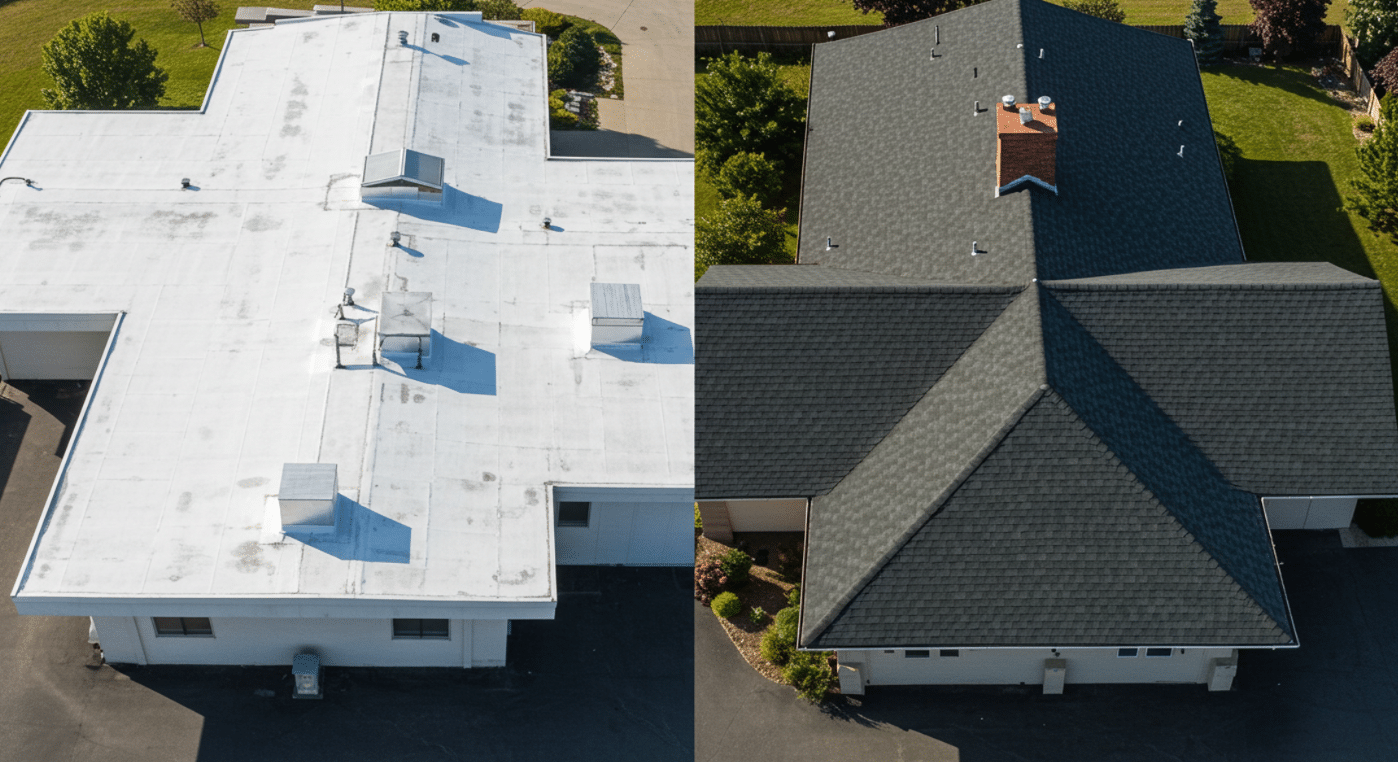
When it comes to selecting the right roofing system for your building project, the decision between a flat roof and pitched roof represents one of the most crucial choices you’ll make. This fundamental architectural decision impacts everything from construction costs and maintenance requirements to energy efficiency and aesthetic appeal.
Whether you’re building a new home, commercial facility, or planning a roof replacement, understanding the distinct advantages and limitations of each roofing style will help you make an informed decision that serves your needs for decades to come.
Both flat and pitched roofing systems have evolved significantly over the past decade, with new materials and installation techniques addressing many traditional concerns. Modern flat roofing systems now offer improved drainage and durability, while pitched roofs continue to provide excellent water runoff and classic architectural appeal. The choice between these two approaches depends on various factors including climate conditions, intended use, budget constraints, and long-term maintenance considerations.
Understanding Flat Roof Systems
Flat roofs, despite their name, are not completely level. They typically feature a slight slope of 1/4 to 1/2 inch per foot to allow for proper water drainage. These low-slope systems are popular in both residential and commercial applications for their versatility and cost-effectiveness.
Common materials include EPDM rubber, TPO, modified bitumen, and built-up roofing systems. With proper installation and maintenance, flat roofs can provide reliable performance for many years.
Here are the main features and benefits of flat roof systems:
- Low-Slope Design for Drainage: The slight slope helps channel water toward drains or gutters. This prevents standing water that could lead to leaks or structural damage.
- Versatile Material Options: Popular choices include EPDM, TPO, modified bitumen, and built-up roofing. Each material offers distinct performance benefits depending on climate and budget.
- Professional Installation Importance: Expert installation ensures correct membrane placement, insulation, and sealing. This prevents pooling water and extends the roof’s lifespan.
- Accessibility for Maintenance: Flat roofs are easier to walk on than pitched roofs, allowing safe inspections and repairs. This accessibility helps identify issues early and keeps maintenance costs lower.
- Space for Equipment and Upgrades: The level surface can accommodate HVAC systems, solar panels, or rooftop gardens. This makes flat roofs a functional choice for maximizing usable space.
Flat roofs combine practicality, affordability, and adaptability, making them a strong option for many property owners when installed and maintained by skilled professionals.
The Benefits and Applications of Pitched Roofs
Pitched roofs typically have slopes ranging from 4/12 to 12/12, with steeper angles offering improved water runoff and snow shedding. When installed with quality materials, they can deliver decades of reliable performance.
Homeowners can choose from a variety of materials, including asphalt shingles, metal roofing, clay tiles, slate, and wood shakes. This combination of durability, versatility, and aesthetic options makes pitched roofs a strong choice for many architectural styles.
Here are the key benefits and applications of pitched roofs:
- Enhanced Water Drainage: The natural slope allows water to flow off quickly, reducing the risk of leaks. This makes pitched roofs ideal for regions with heavy rain or snow.
- Snow and Ice Management: Steeper slopes shed snow more effectively, lowering the chances of ice dam formation. This helps protect the roof and eaves from winter damage.
- Versatile Material Selection: Options such as asphalt shingles, metal, clay, slate, and wood shakes provide flexibility in style and performance. Each material offers unique benefits suited to different climates and budgets.
- Additional Attic Space: The peaked design creates usable attic space that can be used for storage or converted into living areas. This adds functional square footage without expanding the building’s footprint.
- Superior Ventilation Potential: Pitched roofs support effective roof ventilation systems using ridge, soffit, and gable vents. Proper ventilation regulates attic temperatures, reduces energy costs, and prevents moisture-related issues.
With their combination of drainage efficiency, material variety, and added functionality, pitched roofs remain a preferred choice for homeowners in diverse climates and building designs.
Cost Considerations and Installation Factors
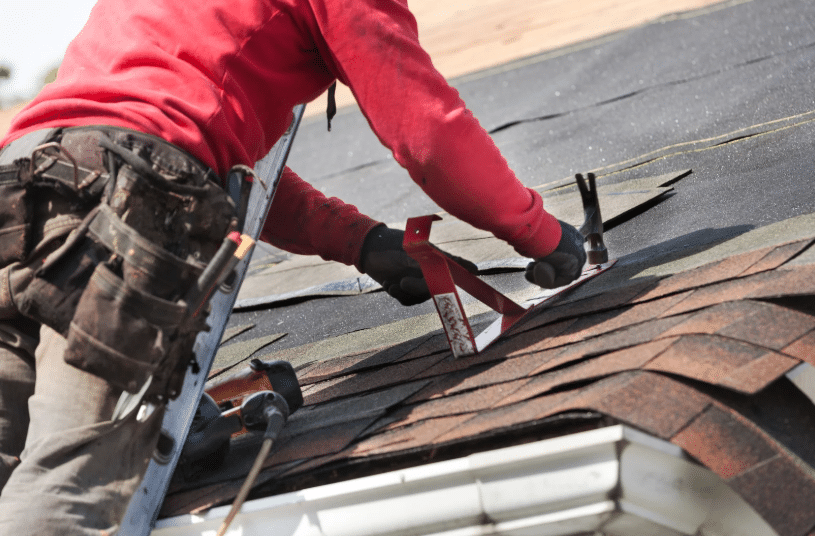
The cost of installing a roof depends on multiple factors, including design, materials, and labor requirements. Flat roofs generally require fewer materials per square foot and are faster to install, which lowers labor costs. Their simplified framing also reduces structural expenses, making them appealing for projects with tight budgets. However, pitched roofs often justify their higher upfront costs with better performance and lower lifetime expenses.
Here are the main cost and installation factors to consider for flat and pitched roofs:
- Material and Labor Costs: Flat roofs use fewer materials and can be installed more quickly. This reduces both material expenses and labor charges compared to pitched systems.
- Framing Requirements: The simpler framing of flat roofs keeps structural costs down. This makes them a cost-effective choice for certain commercial and residential applications.
- Long-Term Value of Pitched Roofs: While pitched roofs cost more initially, their superior drainage and ventilation help them last longer. This often means fewer repairs and replacements over time.
- Maintenance and Repair Expenses: Flat roofs may require more frequent upkeep due to drainage challenges. Pitched roofs generally have lower ongoing maintenance costs.
- Real-World Example: A 2023 commercial project initially chose a flat roof to save on construction costs. After five years of recurring drainage issues and high maintenance expenses, converting to a pitched roof reduced annual upkeep by about 60%.
When choosing between flat and pitched roofs, weigh both the immediate savings and the potential long-term financial impact to make the most informed investment decision.
Performance in Different Climate Conditions
Your local climate is one of the most important factors in choosing between flat and pitched roofing systems. Flat roofs are best suited for dry, arid regions with little rainfall or snow, where the risk of water pooling and snow load is minimal. Pitched roofs perform better in areas with heavy rain, snow, or ice, as their slope encourages rapid water runoff. Considering how your roof interacts with seasonal and extreme weather patterns will help ensure long-term performance and durability.
Here are the key climate-related factors to consider when selecting a roofing system:
- Flat Roofs in Dry Climates: Flat roofs excel in desert and arid regions with consistent dry weather. Low precipitation minimizes drainage concerns and extends the roof’s lifespan.
- Pitched Roofs for Wet and Snowy Areas: Sloped designs quickly shed rain and snow, preventing water buildup. This makes them ideal for regions with heavy precipitation or freeze-thaw cycles.
- Snow Load Management: Pitched roofs naturally shed snow before it becomes a structural hazard. Flat roofs in snowy climates require careful design and reinforcement to handle the added weight.
- Wind Resistance Considerations: High winds can cause uplift forces on flat roofs, while pitched roofs experience varied wind loading depending on slope and orientation. Modern materials and installation methods improve wind resistance for both types.
- Impact of Extreme Weather Events: Severe storms, hail, or hurricanes may affect each roof type differently. Consulting local building codes and weather data helps match your roof design to your region’s challenges.
By aligning your roofing choice with your local climate, you can maximize its performance, longevity, and resistance to weather-related damage.
Maintenance Requirements and Accessibility
Maintenance demands vary greatly between flat and pitched roofs, impacting how often and how complex servicing will be. Flat roofs generally require more frequent inspections to maintain proper drainage and membrane integrity. These systems benefit from bi-annual professional evaluations and immediate attention to any signs of ponding water or damage. Pitched roofs need less frequent upkeep but are harder to access, making safety and professional expertise especially important.
Here are the main maintenance and accessibility considerations for flat and pitched roofs:
- Inspection Frequency for Flat Roofs: Plan for at least two professional inspections each year. This ensures drainage systems work properly and membrane damage is addressed quickly.
- Ease of Access for Flat Roofs: The level surface allows for safe cleaning and minor repairs by property owners. However, significant membrane repairs require professional expertise to maintain waterproofing.
- Specialized Repair Requirements: Flat roofing membranes demand specific techniques and materials. Incorrect repairs can compromise the system’s overall performance.
- Accessibility Challenges for Pitched Roofs: Sloped surfaces make inspections and repairs more dangerous. Professional crews are often required, which can increase service costs.
- Material Longevity and Maintenance: The lifespan of different roofing materials depends heavily on proper care. Regular maintenance extends durability and ensures maximum performance over time.
By understanding the unique maintenance needs of each roof type, property owners can plan effectively for long-term performance and cost management.
Design Flexibility and Architectural Integration
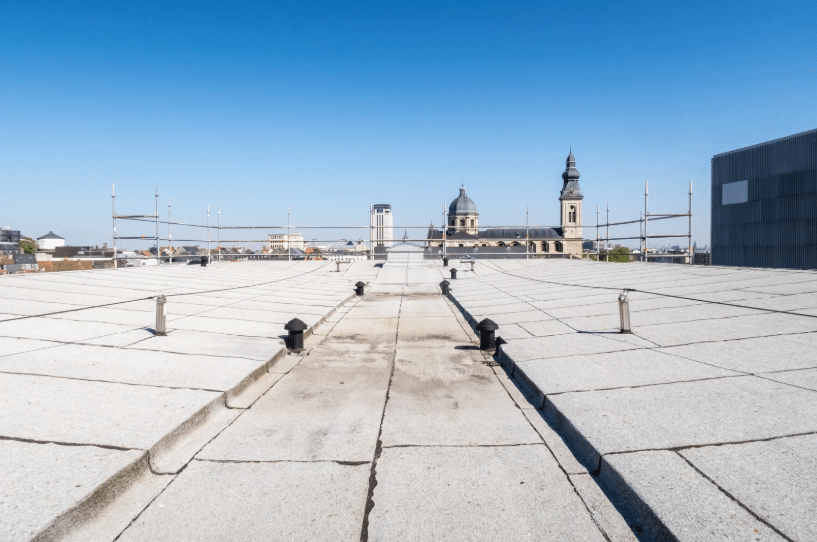
Roof choice often comes down to more than function. Design possibilities and how well a roof complements a building’s architecture play a major role. Flat roofs offer opportunities for rooftop gardens, outdoor living areas, and solar panel installations, adding both value and usability. Pitched roofs, on the other hand, provide timeless curb appeal and suit a wide variety of home styles. Both systems offer unique customization options that can enhance a property’s aesthetic and functional qualities.
Here are the main design and architectural considerations for flat and pitched roofs:
- Usable Space on Flat Roofs: Flat roofs can support gardens, outdoor seating, or even recreational areas. This maximizes space in urban environments where ground-level land is limited.
- Support for Solar and Equipment: Their level surface is ideal for solar panels, HVAC units, and other rooftop systems. This keeps equipment accessible without impacting interior space.
- Modern Styling Potential: Flat roofs deliver clean, minimalist lines that match contemporary designs. They also allow easy integration of skylights and green roofing systems.
- Traditional Appeal of Pitched Roofs: Sloped designs suit architectural styles from colonial to craftsman. Their form adds classic charm while remaining versatile for modern builds.
- Material and Color Customization: Pitched roofs offer a wide range of materials and colors for a tailored appearance. This allows homeowners to match or enhance the home’s architectural character.
- Architectural Details and Features: Pitched designs can include dormers, decorative gables, and complex shapes. These elements add both visual interest and functional benefits like extra natural light.
By considering how each roof type integrates with the property’s design and potential uses, homeowners can choose a system that meets both aesthetic and functional goals.
Key Advantages of Each System
Flat Roof Benefits
- Lower initial installation costs and faster construction timeline
- Accessible surface for maintenance, HVAC equipment, and potential recreational use
- Ideal for solar panel installation due to adjustable mounting angles
- Suitable for buildings requiring frequent roof access for equipment maintenance
- Space efficiency in urban environments with limited ground area
- Modern aesthetic appeal that complements contemporary architecture
Pitched Roof Advantages
- Superior water drainage and natural weather protection
- Longer typical lifespan with proper installation and maintenance
- Enhanced energy efficiency through natural ventilation patterns
- Greater material variety and design flexibility options
- Increased property value and broader market appeal
- Natural attic space for storage or potential living area conversion
Frequently Asked Questions
What is the typical lifespan difference between flat and pitched roofs?
Flat roofs typically last 15-25 years depending on the membrane material and installation quality, while pitched roofs can last 20-50 years or more depending on the roofing material selected.
Asphalt shingles generally last 20-30 years, while metal, tile, and slate roofing can exceed 50 years with proper maintenance. The enhanced drainage of pitched systems contributes to their longer average lifespan.
Are flat roofs more prone to leaks than pitched roofs?
Flat roofs can be more susceptible to water infiltration if not properly installed or maintained, primarily due to the slower water drainage and potential for ponding. However, modern flat roofing materials and installation techniques have significantly improved waterproofing reliability. Proper installation with adequate slope and high-quality membrane systems can provide excellent leak protection comparable to pitched systems.
Which roofing system is better for solar panel installation?
Flat roofs often provide advantages for solar installations because panels can be mounted at optimal angles regardless of the roof’s orientation. This flexibility allows for maximum energy production and easier maintenance access. Pitched roofs can also accommodate solar panels effectively, but the fixed angle may not always be optimal for solar energy collection depending on the roof’s slope and orientation.
Can a flat roof be converted to a pitched roof later?
Converting a flat roof to pitched roof is possible but involves significant structural modifications and costs. The conversion requires adding new framing systems, potentially reinforcing existing structures, and completely rebuilding the roofing system.
While feasible, such conversions typically cost more than installing a pitched roof system initially, making it important to consider long-term plans during initial construction.
What are the insurance implications of choosing flat versus pitched roofing?
Insurance premiums may vary between roofing systems based on regional risk factors and historical claim data. Some insurers view flat roofs as higher risk due to potential drainage issues, while others recognize modern flat roofing improvements.
Pitched roofs generally receive favorable insurance treatment due to their proven weather resistance. Consult with insurance providers to understand potential premium differences for your specific location and building type.
Find the Right Roofing Solution for Your Home or Commercial Property
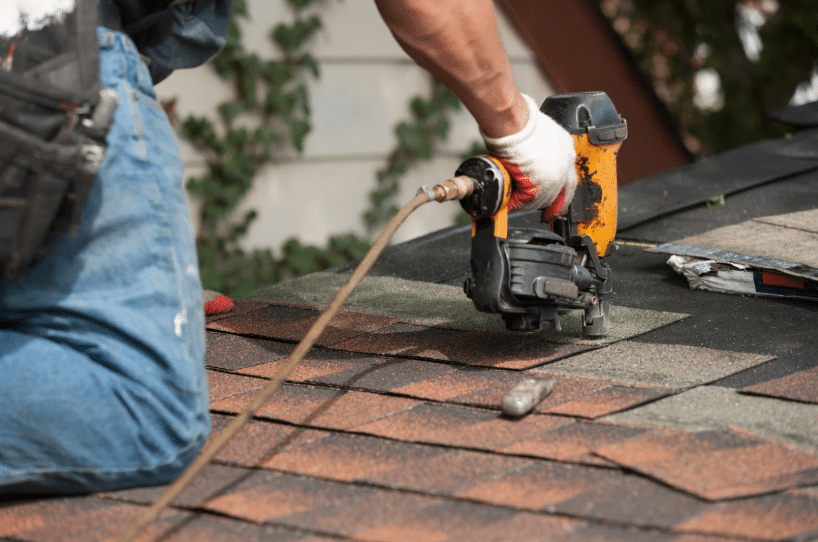
Selecting between flat and pitched roofing systems requires careful consideration of multiple factors including climate conditions, intended building use, budget constraints, and long-term maintenance preferences. Both systems offer distinct advantages when properly designed and installed by experienced professionals. The key to success lies in matching the roofing system to your specific needs and ensuring quality installation that maximizes performance and longevity.
Consider consulting with roofing professionals who can evaluate your specific situation and provide detailed recommendations based on local conditions and building requirements. Veteran Brothers Roofing & Restoration offers comprehensive evaluations and expert installation services to help you make the best decision for your roofing investment.
About Veteran Brothers Roofing & Restoration
Veteran Brothers Roofing & Restoration specializes in comprehensive roofing solutions with over 15 years of experience serving residential and commercial clients throughout the region. We provide expert installation, maintenance, and repair services for both flat and pitched roofing systems, including membrane roofing, asphalt shingles, metal roofing, and tile installation. Our team of certified roofing professionals combines technical expertise with industry knowledge to deliver superior weather protection and long-term performance.
We pride ourselves on using premium materials, proven installation techniques, and thorough quality control processes that ensure every roofing system meets the highest standards. Our comprehensive approach includes proper ventilation design, drainage planning, and preventive maintenance programs that maximize roof lifespan and minimize unexpected repair costs. We’ve helped over 2,000 clients achieve reliable roofing solutions that protect their investments and provide peace of mind for decades.
Contact Veteran Brothers Roofing & Restoration today at (817) 875-9834 to discuss how our roofing expertise can help you select and install the ideal roofing system for your specific needs. Schedule a consultation to learn more about our professional installation services and how we’ve helped clients achieve outstanding results with both flat and pitched roofing solutions.
INCOMING MESSAGE
It’s storm season. If you think there’s been storm damage to your roof, or would simply like the peace of mind of knowing you’re in the clear, Veteran Brothers is here to help.

